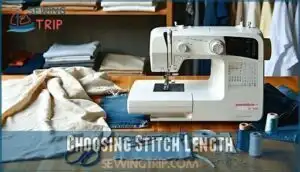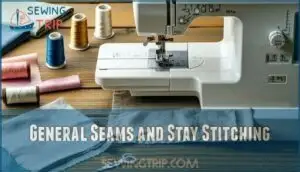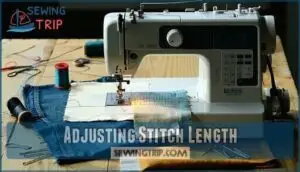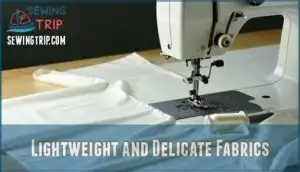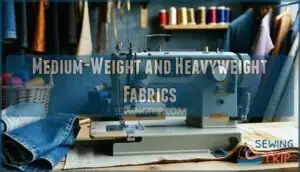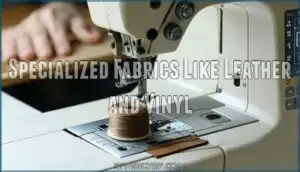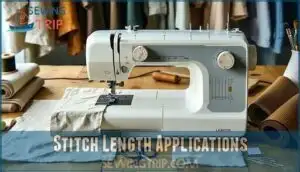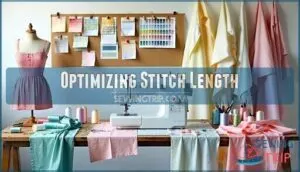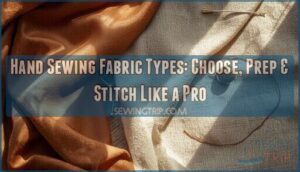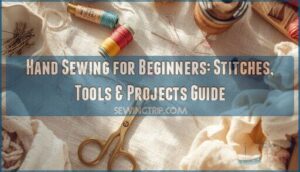This site is supported by our readers. We may earn a commission, at no cost to you, if you purchase through links.

You’ll typically use 1.5-2mm for delicate fabrics, 2.5mm for standard seams, and 3-4mm for basting or heavyweight materials.
Your fabric weight determines the perfect setting – lightweight fabrics need shorter stitches to prevent puckering, while thick materials require longer ones for proper penetration.
Thread thickness also matters since heavier threads need more space.
Modern machines let you adjust incrementally, but remember that shorter stitches create stronger seams while longer ones work faster for temporary work.
The key lies in matching your stitch length to both fabric characteristics and project purpose for professional results that won’t let you down when it counts.
Table Of Contents
Key Takeaways
- Match stitch length to your fabric weight – You’ll need 1.5-2mm for delicate materials, 2.5mm for standard fabrics, and 3-4mm for heavyweight materials to prevent puckering and ensure proper seam strength.
- Consider your project’s purpose when selecting length – You’ll use shorter stitches (1.5-2.5mm) for permanent seams that need durability, while longer stitches (4-7mm) work best for temporary basting and gathering.
- Adjust for thread thickness and needle size – You’ll need longer stitches when using heavy topstitching thread to prevent bunching, and you should match your needle size to accommodate thicker threads properly.
- Test settings on fabric scraps first – You’ll save time and avoid mistakes by testing your stitch length adjustments on leftover fabric before starting your actual project, ensuring professional results every time.
Stitch Length Basics
Understanding stitch length is your first step toward professional-looking sewing results, as it’s simply the distance between each needle puncture measured in millimeters.
You’ll find that mastering this basic concept transforms how your fabric behaves under the needle, whether you’re working with delicate silk or sturdy denim, leading to better sewing outcomes.
Definition of Stitch Length
Stitch length defines the distance between consecutive needle punches during each sewing machine step.
When your needle creates holes in fabric, the space between these needle entry points determines your stitch length. Your machine’s stitch regulator controls this distance between stitches, typically measured through a stitch length selector.
Understanding this fundamental concept helps you achieve consistent results across different fabrics and projects, using your machine’s settings to control the distance between each needle punch.
Measurement in Millimeters
Modern sewing machines use millimeter measurements for metric precision, displaying stitch length on the regulator display from 0 to 5mm.
Your stitch length selector allows incremental changes in 0.1mm steps, following the European standard system.
Understanding millimeter measurements helps with formula application when converting between metric and imperial units.
This standard stitch length measurement system guarantees consistent results across different machine brands.
Conversion to Stitches Per Inch
Understanding stitch length conversion helps you adapt vintage patterns to modern sewing machines.
While today’s machines use millimeters, older patterns specify stitches per inch (SPI).
The SPI formula makes this conversion simple: divide 25.4 by your stitch length in millimeters to get stitches per inch.
A general sewing project often uses 2.5mm stitch length.
- Historical Context: Vintage patterns from the 1970s and earlier used SPI measurements before metric conversion became standard
- Pattern Adaptations: Converting allows you to follow grandmother’s recipes with precision on your computerized sewing machine
- Accuracy Factors: Double-check your stitch length regulator settings since small measurement errors affect seam quality substantially
Choosing Stitch Length
When choosing stitch length, you’ll need to take into account three key factors that work together to create the perfect seam.
Your fabric type, the stitch’s purpose, and thread thickness all influence which setting will give you professional results every time.
Fabric Type Considerations
Your fabric’s weight dictates the perfect stitch length.
Lighter fabrics need shorter stitches to prevent puckering, while heavier materials require longer stitches.
Knit stretches demand medium settings for flexibility, and specialty fabrics have unique requirements.
| Fabric Type | Weight Category | Recommended Stitch Length |
|---|---|---|
| Silk, Chiffon | Lightweight | 1.5-2.0 mm |
| Cotton, Linen | Medium-Weight | 2.0-2.5 mm |
| Denim, Canvas | Heavyweight | 3.0-4.0 mm |
| Jersey, Knits | Stretch Materials | 2.5-3.0 mm |
The table provides a quick reference for common fabric types and their corresponding stitch lengths, helping you choose the right setting for your project, considering the fabric type and its weight.
Purpose of The Stitch
Your project requirements determine which stitch length works best for each sewing task.
Shorter stitches create stronger seam durability at stress points, while longer stitches suit basting and gathering.
Consider stitch appearance too—topstitching needs different stitch length adjustment than regular seams.
Match your stitch length control to the job at hand for ideal fabric handling and professional results.
Thread Thickness Factors
Thread thickness directly impacts your stitch length selection.
Heavy threads like topstitching thread require longer stitches to prevent bunching, while fine threads work well with shorter lengths.
Match your needle size to thread weight—larger needles accommodate thicker threads but create bigger holes.
Adjust tension settings accordingly, as thick threads need looser tension to flow smoothly through fabric density variations.
For best results, consider thread fiber content to guarantee compatibility and durability.
Standard Stitch Lengths
Mastering standard stitch lengths transforms your sewing from amateur to professional-quality results.
You’ll discover the specific measurements that create perfect seams for different fabrics and purposes, eliminating guesswork from your projects, which leads to professional-quality results.
General Seams and Stay Stitching
For general seams and stay stitching, you’ll want to set your machine to a standard stitch length of 2.0-2.5mm.
This range provides ideal seam durability while maintaining stitch consistency across most medium-weight fabrics.
Stay stitching requires the shorter end at 2.0mm to prevent fabric distortion along curved edges.
Your tension settings and needle type should complement this length, ensuring the seam allowance holds securely without puckering or stretching during construction, which is crucial for maintaining overall fabric integrity.
Curves and Knit Fabrics
When sewing curves and knit fabric, you’ll need strategic stitch length adjustment to achieve professional results.
Shorter stitches around 2.0-2.5mm help you navigate tight curves smoothly, while knit fabrics benefit from slightly longer stitches to accommodate their natural stretch without breaking threads.
- Curve Stitching: Use 2.0-2.5mm stitch length for smooth, controlled turns around corners and curved seams
- Knit Tension: Set 2.5-3.0mm length to prevent thread breakage when fabric stretches during wear
- Fabric Feed: Adjust differential feed settings on sergers to prevent stretching while maintaining proper stitch formation
- Serger Stitches: Use 3-4 thread overlock with medium stitch length for professional knit seam finishing
Adjusting Stitch Length
You’ll find adjusting stitch length straightforward once you understand your machine’s controls. Whether you have a mechanical dial or computerized touchscreen, making these changes becomes second nature with practice.
Mechanical Vs Computerized Machines
Whether you’re adjusting stitch length on a mechanical sewing machine with its trusty dial or operating a computerized model’s digital interface, each type offers distinct advantages for stitch customization.
You can find a variety of these machines available for different sewing needs.
| Feature | Mechanical Sewing Machine | Computerized Sewing Machine |
|---|---|---|
| Adjustment Method | Physical dial or knob labeled "length" | Touchscreen buttons or LED display controls |
| Precision Level | Manual settings with visible markings | Digital precision with 0.1mm increments |
| Automation Features | Basic stitch length adjustment only | Memory settings and automatic stitch optimization |
| Repair Complexity | Simple mechanical parts, easier fixes | Complex electronics requiring specialized service |
| Cost Comparison | Lower initial investment | Higher price but advanced stitch length adjustment features |
Feed Dog Adjustment
Feed dogs control fabric thickness and movement beneath your sewing machine needle, directly impacting stitch length accuracy.
These metal teeth adjust height automatically based on tension settings, preventing slippage and uneven fabric feeding.
Specialty feed dogs handle different materials better, while proper feed dog height guarantees consistent fabric feed control across varying fabric thickness for professional results.
Regular maintenance prevents common feed dog problems to ensure professional results and maintain proper fabric feed control.
Incremental Adjustments
Fine-tuning your stitch length regulator gives you incremental control over precision sewing.
Most machines adjust in 0.1mm or 0.5mm steps, letting you dial in perfect stitch quality through micro-adjustments.
You’ll master the sweet spot between standard stitch length and your fabric’s needs.
Achieving the perfect stitch might require a micro stitch tool for ideal results.
These small tweaks make huge differences—turning amateur seams into professional-grade results that’ll make you wonder why you ever settled for "close enough.
Stitch Length for Fabrics
Choosing the right stitch length for your fabric makes the difference between professional-looking seams and disappointing results.
Different fabrics require specific stitch lengths to prevent puckering, guarantee durability, and maintain the fabric’s natural drape.
Lightweight and Delicate Fabrics
Delicate silk-weights demand finesse with your stitch length regulator.
Short stitches between 1.5-2.0mm prevent puckering and maintain fabric integrity.
Proper needle selection and thread tension adjustments complement these shorter settings for professional seam finishes.
It’s important to have quality sewing tools for best results.
Essential considerations for lightweight fabrics:
- Use 1.5-2.0mm stitch length to prevent fabric distortion
- Select fine needles (size 60-70) to minimize puncture damage
- Adjust thread tension lower to reduce fabric pulling
- Consider stabilizer use for extremely delicate materials
- Test stitch settings on fabric scraps before beginning your project
Medium-Weight and Heavyweight Fabrics
Medium-weight fabrics like denim stitching and canvas seams require standard stitch length settings of 2.0-2.5mm on your sewing machine.
Heavyweight fabrics need longer stitches—3.0-4.0mm works best for upholstery length projects and thick fabric layers.
Adjust your machine’s feed dogs to accommodate fabric thickness, as these stitch types prevent thread breakage while ensuring strong, professional seams.
Specialized Fabrics Like Leather and Vinyl
Leather and vinyl demand longer stitch lengths than standard fabrics to prevent weakening from excessive perforations.
Set your machine to 3.0-4.0mm for leather stitching and vinyl sewing.
These synthetic materials and thick fabrics require heavy duty settings to maintain seam strength.
Shorter stitches create too many needle holes, compromising fabric thickness integrity and potentially causing tears along seam lines.
For ideal results, consider using proper leather sewing techniques to achieve professional-looking finishes with proper techniques.
Stitch Length Applications
You’ll discover that different sewing projects require specific stitch lengths to achieve professional results.
Understanding when to use short, medium, or long stitches transforms your sewing from amateur to expert-level craftsmanship.
Basting and Gathering
Basting uses the longest stitch length settings—typically 4.0 to 7.0mm—for easy basting removal when temporarily holding fabric pieces.
For gathering stitch operations, you’ll want 4.0mm lengths to create proper gathering density while maintaining fabric control.
Adjust your machine’s tension settings slightly looser than normal to prevent thread breaks, allowing for smooth tension adjustment when pulling threads to create decorative gathers in your projects, which enables easy tension adjustment.
Quilting and Embroidery
When you’re quilting or working on embroidery designs, precision becomes your best friend.
Machine piecing quilt blocks thrives with 2.0-2.5mm stitches, while hand quilting typically uses 3.5-4.0mm for consistent results.
Here’s your stitch length roadmap:
- Machine quilting: 2.5-3.5mm delivers balanced strength and appearance
- Foundation paper piecing: 1.5-2.0mm makes paper removal easier
- Embroidery work: 1-2mm creates sharp, clean borders in satin stitches
- Free motion quilting: Set at 2.5-3.5mm but control manually
Test your fabric selection and thread colors on scraps first—this prevents headaches later when perfecting those intricate stitch patterns.
For ideal results, consider the stitch length guidelines to achieve a balanced and consistent stitch pattern.
Decorative Topstitching
Decorative topstitching transforms ordinary seams into eye-catching design elements.
You’ll want longer stitch lengths of 3.0-4.0mm to showcase thread colors and create bold stitch patterns.
Experiment with contrasting threads and varied topstitch techniques across different fabric choices.
Adjust stitch tension carefully—loose tension causes looping while tight tension puckers fabric.
Quality embellishments require consistent stitch length and proper thread selection for professional-looking decorative stitches.
Optimizing Stitch Length
You’ll achieve professional results when you match your stitch length to your fabric and purpose.
Getting this balance right prevents puckering, strengthens seams, and makes your finished projects look store-bought rather than homemade.
Preventing Uneven Stitches
Uneven stitches often result from improper tension control and inconsistent stitch length settings.
Check your thread tension first—loose tension creates loops while tight tension puckers fabric.
Proper fabric preparation prevents feeding issues that cause stitch length problems, and selecting the correct needle for your material weight is also crucial.
Maintain steady sewing speed for consistent stitch quality, and ensure your machine’s stitch length control matches fabric thickness for ideal results.
Enhancing Seam Strength
Durability becomes your seam’s secret weapon when you master stitch length control.
Shorter stitches create higher stitch density, boosting thread strength and seam security substantially.
Use 1.5-2.5mm for maximum seam reinforcement on stress points like pocket corners and armholes.
This increased stitch durability prevents fabric tension from weakening your work, ensuring durable seams that withstand repeated washing and wear.
Improving Professionalism in Sewing Projects
Professional sewing hinges on consistent stitch quality and proper fabric selection.
You’ll achieve polished results by matching your stitch regulator settings to each project’s requirements. Standard stitch length works for most seams, but precision sewing demands adjustments based on material weight and purpose.
Master these sewing techniques through careful project planning—test settings on scraps first. Converting between millimeters and stitches per inch becomes second nature with practice.
Understanding advanced sewing techniques is essential for achieving professional results in various sewing projects, which requires a good understanding of sewing techniques and project planning.
Frequently Asked Questions (FAQs)
How to know what stitch length to use?
Choose your stitch length based on fabric weight and purpose.
Use 5-0mm for delicate fabrics, 0-5mm for standard seams.
Use 0-0mm for heavy materials, and 0-0mm for basting.
What does 5 stitch length mean?
A 5mm stitch length means your machine creates stitches with 5 millimeters of space between each needle entry point.
This standard setting works perfectly for most everyday sewing projects on medium-weight fabrics.
What sets the length of the stitches on a sewing machine?
Your sewing machine’s feed dogs control stitch length by moving fabric forward with each needle penetration.
You’ll adjust this using the stitch length dial or digital controls, which changes how far the feed dogs advance the fabric between stitches.
What causes skipped stitches when sewing?
Don’t put the cart before the horse—skipped stitches happen when you’re using the wrong needle, threading incorrectly, or sewing too fast for your fabric’s weight and thickness.
How do temperature changes affect stitch quality?
Temperature fluctuations directly impact thread tension, causing loose or tight stitches.
Cold environments make thread brittle and prone to breakage, while heat softens materials, creating uneven stitches and potential puckering issues.
Why do some stitches pucker fabric?
Puckering happens when you’re using stitches that are too short for your fabric weight, creating excessive tension that pulls and distorts the material into unsightly wrinkles.
When should you backstitch at seam ends?
Always backstitch at seam beginnings and ends to secure stitches and prevent unraveling. You’ll avoid frustrating repairs later when threads work loose during wear or washing.
How often should you change needle sizes?
Needle manufacturers recommend changing sewing machine needles every 8-10 hours of sewing time.
You’ll know it’s time when you hear popping sounds, see thread fraying, or notice skipped stitches and fabric pulls.
Conclusion
Mastering various stitch lengths explained transforms your sewing from amateur attempts to professional perfection.
You’ve learned that fabric weight, thread thickness, and project purpose determine your ideal settings.
Remember that 2.5mm works for most standard seams, while delicate fabrics need shorter stitches and heavyweight materials require longer ones.
Practice adjusting these settings on fabric scraps before starting important projects.
Your attention to proper stitch length will create stronger seams, prevent puckering, and deliver polished results every time.

